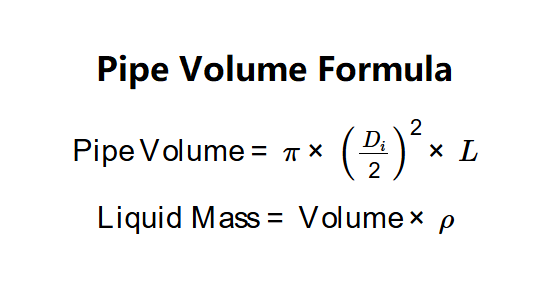1. What is Pipe Volume Calculator?
Definition: This calculator computes the inner volume of a pipe and, optionally, the mass of liquid it can hold based on the liquid's density.
Purpose: It is used in engineering, plumbing, and construction to determine the capacity of pipes for holding liquids, such as water or fuel, and to estimate the weight of the liquid for structural or logistical planning.
2. How Does the Calculator Work?
The calculator uses the following equations:
- \( \text{Pipe Volume} = \pi \times \left(\frac{D_i}{2}\right)^2 \times L \)
- \( \text{Liquid Mass} = \text{Volume} \times \rho \)
Where:
- \( D_i \): Inner diameter of the pipe (converted to meters for calculation);
- \( L \): Length of the pipe (converted to meters for calculation);
- \( \rho \): Density of the liquid (converted to kg/m³ for calculation);
- \( \pi \approx 3.14159 \);
- Volume is initially calculated in m³, then converted to the selected unit (mm³, cm³, m³, in³, ft³, yd³, L);
- Mass is initially calculated in kg, then converted to the selected unit (g, kg, lb, oz, ton, uston).
Steps:
- Enter the inner diameter (\( D_i \)) and its unit (cm, dm, m, in, ft).
- Enter the pipe length (\( L \)) and its unit (cm, dm, m, in, ft).
- Check the box to calculate liquid mass if desired.
- If calculating mass, enter the liquid density (\( \rho \)) and its unit (kg/m³ or lb/ft³).
- Convert all measurements to meters.
- Calculate the volume: \( \text{Volume} = \pi \times \left(\frac{D_i}{2}\right)^2 \times L \).
- Convert the volume to the selected result unit (mm³, cm³, m³, in³, ft³, yd³, L).
- If calculating mass, convert volume to m³ if needed, convert density to kg/m³, then calculate: \( \text{Mass} = \text{Volume} \times \rho \).
- Convert mass to the selected result unit (g, kg, lb, oz, ton, uston).
- Display results: pipe volume and, if requested, liquid mass, with units included in the values, formatted in scientific notation if the absolute value is less than 0.001, otherwise with 4 decimal places.
3. Importance of Pipe Volume Calculation
Calculating pipe volume is crucial for:
- Capacity Planning: Determines how much liquid a pipe can hold, essential for plumbing and fluid transport systems.
- Weight Estimation: Calculates the mass of the liquid for structural design or transportation considerations.
- Resource Management: Helps in estimating material needs for filling pipes, such as water for testing or fuel for storage.
4. Using the Calculator
Example 1 (Volume in Liters, Metric Units): Calculate the volume of a pipe:
- Inner Diameter: \( D_i = 20 \, \text{cm} \);
- Convert \( D_i \): \( D_i = 20 / 100 = 0.2 \, \text{m} \);
- Length: \( L = 5 \, \text{m} \);
- Radius: \( \frac{D_i}{2} = 0.1 \, \text{m} \);
- Volume: \( \text{Volume} = \pi \times (0.1)^2 \times 5 \);
- \( \text{Volume} = \pi \times 0.01 \times 5 \approx 0.1571 \, \text{m}^3 \);
- Convert to Liters: \( 0.1571 \times 1000 = 157.1 \, \text{L} \);
- Result: Pipe Volume = 157.0796 L.
Example 2 (Volume in in³ and Mass in lb, Mixed Units): Calculate the volume and mass of water in a pipe:
- Inner Diameter: \( D_i = 6 \, \text{in} \);
- Convert \( D_i \): \( D_i = 6 \times 0.0254 = 0.1524 \, \text{m} \);
- Length: \( L = 10 \, \text{ft} \);
- Convert \( L \): \( L = 10 \times 0.3048 = 3.048 \, \text{m} \);
- Radius: \( \frac{D_i}{2} = 0.0762 \, \text{m} \);
- Volume: \( \text{Volume} = \pi \times (0.0762)^2 \times 3.048 \);
- \( \text{Volume} \approx \pi \times 0.00580644 \times 3.048 \approx 0.0556 \, \text{m}^3 \);
- Convert to in³: \( 0.0556 \times 61023.7 \approx 3392.92 \, \text{in}^3 \);
- Density of Water: \( \rho = 1000 \, \text{kg/m}^3 \);
- Mass in kg: \( \text{Mass} = 0.0556 \times 1000 = 55.6 \, \text{kg} \);
- Convert to lb: \( 55.6 \times 2.20462 \approx 122.58 \, \text{lb} \);
- Result: Pipe Volume = 3392.9165 in³, Liquid Mass = 122.5769 lb.
5. Frequently Asked Questions (FAQ)
Q: Why use the inner diameter instead of the outer diameter?
A: The inner diameter determines the actual space available for liquid inside the pipe, while the outer diameter includes the pipe wall thickness.
Q: How do I convert cubic meters to liters?
A: Multiply the volume in cubic meters by 1000 to get the volume in liters.
Q: What is the difference between ton and uston?
A: 'Ton' refers to a metric ton (1000 kg), while 'uston' refers to a US ton (2000 lb, approximately 907.185 kg).
 Home
Home
 Back
Back
